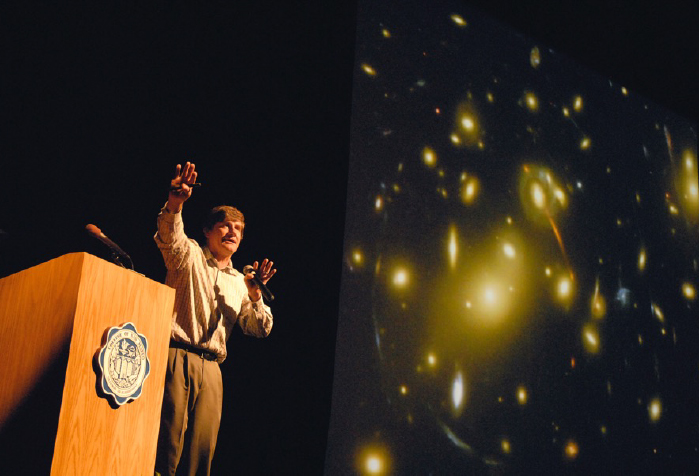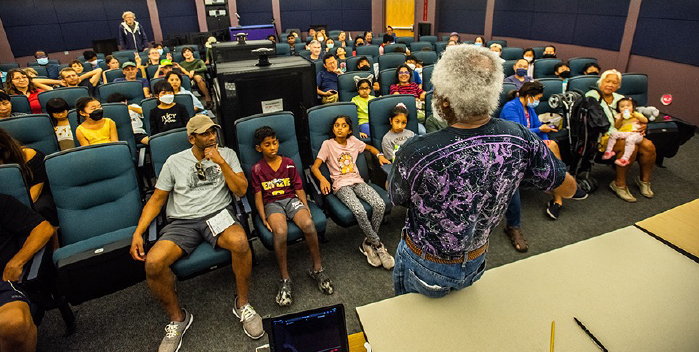
Family Science Day
It’s all associated with the idea of bringing science to the community. And that, anyway, has been the mission of my life.
– Mohsen Janatpour
Family Science Day is one of the longest-running and best-loved events at College of San Mateo, having delighted the public with stargazing, planetarium shows and science workshops since 2006.
Free to the public and drawing thousands of visitors yearly, Family Science Day is put on with the help of the San Mateo County Astronomical Society and many CSM staff, departments and student volunteers. Distinguished astrophysicists share their work with the public, while kids get a chance to make models, explore scientific concepts and look through telescopes with astronomers who explain what they are seeing.
This year’s event is set for Saturday, September 30, 2023.
Family Science Day is the brainchild of Mohsen Janatpour, professor of physics and astronomy at CSM. The idea germinated years ago when he was asked to do science demos at his kids’ public schools.
“I took magnets, lasers and electrical material from CSM science labs to the schools to demonstrate a lot of physical laws,” Janatpour said. “I made the lasers do patterns. I’d attach a wheeled cart to a magnet, so the kids could move the cart without touching anything. They’d feel powerful.”
Meanwhile, the San Mateo County Astronomical Society, a group of amateur astronomers and enthusiasts that has met since 1960, had encountered a schedule conflict at its longtime venue at Foster City’s Bowditch Middle School.
“Mike Neyman, their president, approached me,” Janatpour said. “We decided to move them from Bowditch to our planetarium, where they put on their once-a-month stargazing days and a speaker series. That was the catalyst. We decided to have the public join us on special occasions.”
The first such occasion was in 2003, when Mars made its closest approach to Earth in 60,000 years. More than 5,000 people thronged to CSM’s telescopes to clearly see the Red Planet’s ice caps and other geological features.
“The old planetarium seated 70 people, max. It was where Building 10 is now,” Janatpour said. “I saw the crowd going into and out of the planetarium with long lines going around and around the building, and I asked, ‘Why not have this on a more regular basis?’”
At the same time, the Astronomical Society was heavily involved in helping CSM fund and build its new Integrated Science Building, especially its new planetarium.
“Members contributed stars inside the planetarium foyer that mark their donations. I’ve got a big star there myself,” said society member Ed Pieret, who joined in 2001 after taking a class from Astronomy Professor Darryl Stanford. Members also worked hard on voter education for the related construction bond.


CSM Astronomy Professor Darryl Stanford introduces a planetarium show at the 2022 event, which was expanded into a Centennial Science Week to celebrate both CSM’s 100th birthday and its emergence from COVID-19 restrictions.

Mohsen Janatpour, professor of physics and astronomy at CSM and Family Science Day’s founder, explains models of the human brain to young visitors at the 2022 event.
The first Family Science Day was held soon after the Integrated Science Building’s opening in 2006. CSM faculty from other science disciplines, including Professors Kathy Diamond and Carlene Tunini-Boutacoff in biology and Professor Linda Hand in geology, joined in to give workshops.
In 2014, while running seminars for CSM’s Honors Program, Janatpour happened to meet with then-Librarian Lorrita Ford, who had started the CSM Library Makerspace the year before.
“I said to her, ‘How would you like to join forces and include Makerspace as part of Family Science Day?’ We brought the library in, then thought, why stop there? I asked the Astronomical Society of the Pacific to join us. Charlene Frontiera, dean of the Math and Science Division, was key in having the College provide the funding and helping organize the events. I went to then-President Mike Claire and asked, ‘Could you give me a budget?’ And he did.”
“I didn’t want to stop there, so I approached the music department and asked them if they wanted to play music during Family Science Day. We had live music after the keynote address from the jazz ensemble. One year it was very foggy and we couldn’t see any stars. So the public came and danced in the observatory.”
CSM student clubs, including the Astronomy Club, Physics Club, Biology Club, Geology Club, and Nursing Club run information tables, while other student volunteers help guide the public, set up demos, and serve during keynote-speaker receptions. The San Mateo County Astronomical Society sets up exhibits and workshops such as making constellation-finders or explaining how telescopes operate. Members also provide a solar observatory to safely look at the sun. For the last 10 years, Pieret has been ‘the Comet Chef,’ cooking up a comet nucleus with dry ice and water.
“Because that’s all a comet nucleus is,” Pieret said. “But it’s very dramatic and gets a lot of attention.”
Last year, at Janatpour’s request, the society set up a walkable scale model of the solar system, starting at the pedestrian bridge between the Science Building and the rest of campus.
“The sun was a meter across on the wall. And the planets were tiny beads on sandwich boards on the walkway,” Pieret said. “I got as far as Mars before we could no longer walk along the orbit paths to scale. Jupiter, the size of a marble, would have been at CSM’s Theatre. Saturn would have been off college property.”
“It gives you an idea of the scale of the solar system, which is mind-blowing,” Pieret said.
In addition to the workshops and planetarium shows, a big draw is the annual keynote address by a prominent space scientist.
In 2011, CSM audiences heard from a speaker whose work contributed to that year’s Nobel Prize in physics. Astrophysicist Alexei Filippenko from the University of California, Berkeley, gave the keynote address on “Dark Energy and the Runaway Universe,” presenting evidence derived from Type Ia supernovas that the expansion of the universe is not slowing, as was commonly believed, but is in reality accelerating. As a member of both the Supernova Cosmology Project and the High-Z Supernova Search Team, Filippenko shared in the 2007 Gruber Cosmology Prize and the 2015 Breakthrough Prize in Fundamental Physics for this work, while team leaders Saul Perlmutter, Adam Riess and Brian Schmidt were named as the 2011 Nobel recipients.
In 2012, keynote speaker G. Seth Shostak, senior astronomer at the SETI Institute, which studies the search for extraterrestrial life, landed CSM and Family Science Day on the CBS Evening News. A meteor shower coincidentally occurred that day, and CBS sent a reporter to campus to interview Shostak about it.
Last year, attendees learned about the first images from NASA’s James Webb Space Telescope, which orbits the Sun at Lagrange Point 2 (or 1.5 million kilometers) from Earth. Keynote speaker Thomas Greene of Ames Research Institute, who helped develop the telescope, explained Webb’s unique capability: with six times more light-reflecting power than the Hubble Space Telescope, Webb can for the first time give humans a glimpse inside the dust clouds where stars and planetary systems form.
Greene’s talk keynoted a Family Science Week that celebrated not only CSM’s centennial but also its reopening to in-person community outreach after two years of virtual events prompted by COVID-19.

